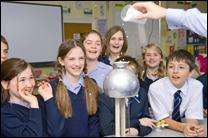Nearly half (49%) of all co-ed maintained schools in England do not send even one girl on to do physics A-level, a new report from the Institute of Physics (IOP) reveals today.
Using records of A-level examinations sat in 2011 from the National Pupil Database, IOP reports a startling picture of the uneven education landscape that denies swathes of female students an engaging physics experience.
In the new IOP report, entitled "It's Different for Girls", out today, Wednesday 3 October, the failure of many schools to ensure equal opportunity for boys and girls is laid bare.
Professor Sir Peter Knight, President of IOP, said, "Physics is a subject that opens doors to exciting higher education and career opportunities. This research shows that half of England's co-ed comprehensives are keeping these doors firmly shut to girls."
Although this is not a new problem – the proportion of those choosing A-level physics who are girls has been stubbornly consistent, at around 20 percent, for more than 20 years – evidence from the database helps confirm the source of the problem.
There is a revealing discrepancy between co-ed and single sex schools with girls being almost two and a half times more likely to go on to do physics A-level in an all-girls' school.
A further discrepancy, which supports previous research, is that the worst-served girls are those who attend co-ed schools that do not have a sixth form.
Clare Thomson, Curriculum and Diversity Manager at IOP, explains, "The importance of having a sixth form in your school for uptake of physics is related to the availability of specialist physics teachers – a factor we know contributes to enjoyment of and engagement with the subject across both sexes.
"Schools that have a sixth form are more likely to have specialist physics teachers on their staff and these teachers' confident and enthusiastic teaching of the subject inspires a greater number of students to progress on to A-level physics and beyond."
The findings support earlier research which suggests that girls are often turned off physics for three key reasons: their experience of physics at school, their teacher-student relationship and students' own developing sense of identity – how they see themselves in relation to the subject, which can be informed by a wide range of influences.
Professor Knight writes in the new report's Foreword, "Perceptions of physics are formed well beyond the physics classroom: the English teacher who looks askance at the girl who takes an interest in physics or the lack of female physicists on television, for example, can play a part in forming girls' perceptions of the subject.
"We need to ensure that we are not unfairly prejudicing girls against a subject that they could hugely benefit from engaging with."
IOP makes a series of recommendations to government and its agencies, head teachers and parents alongside the report, including a request to Ofsted that gender equity be part of the school inspectors' criteria.
IOP is currently working with the Department for Education on a major project, the Stimulating Physics Network, supporting schools to improve access for all students and as part of this IOP is trialing ways of making physics more attractive to girls.
More information: See the full report and the IOP's recommendations for change here: www.iop.org/girlsinphysics
Provided by Institute of Physics


















